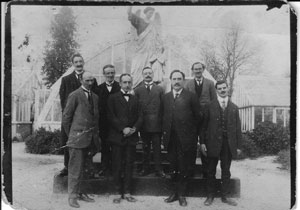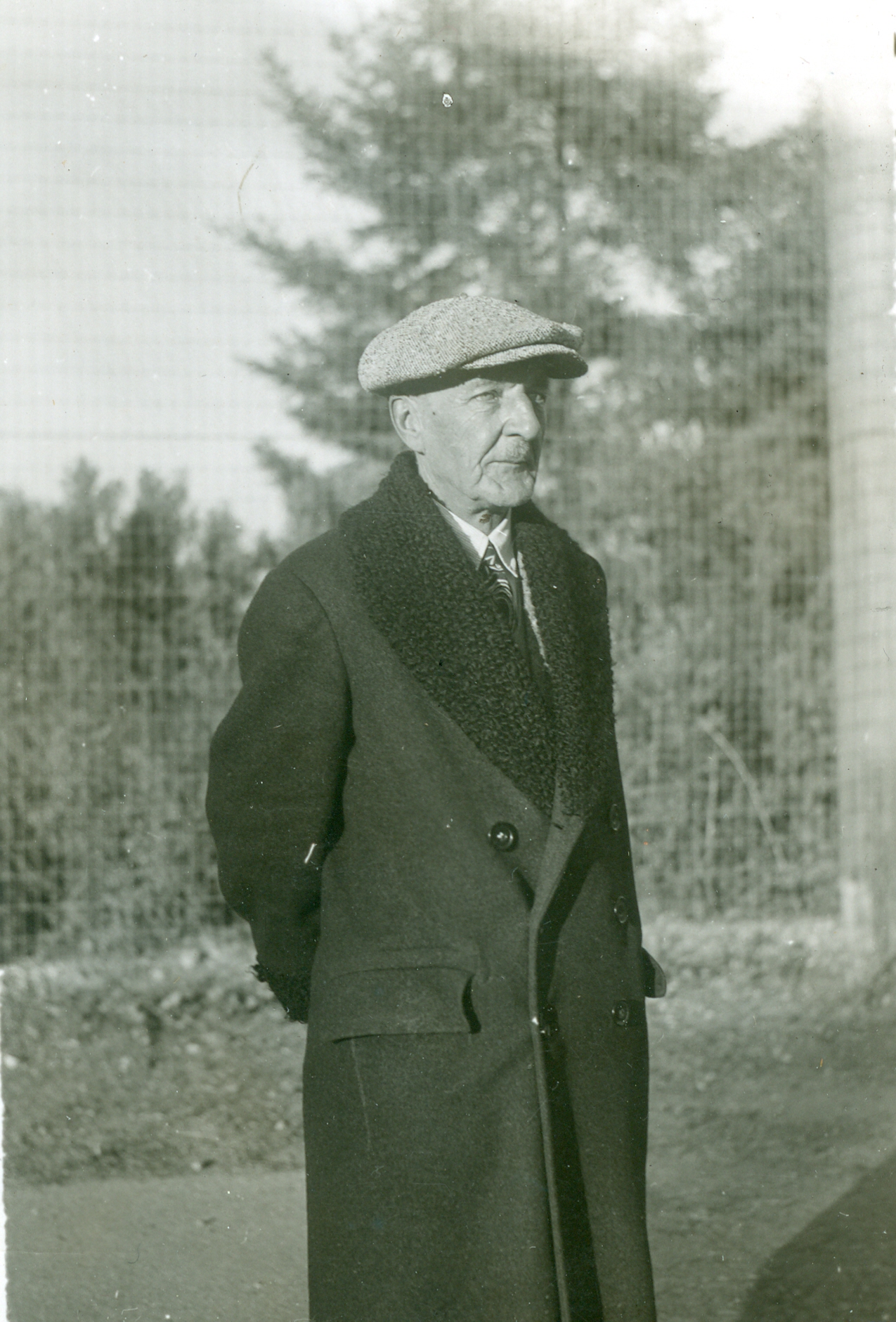The Boyd Barretts and the new Irish state
Published in Features, Issue 4 (July/August 2020), Volume 28Privilege and change in the Catholic middle class.
BY COLUM KENNY

Above: Health inspection for new immigrants at Ellis Island, New York, c. 1920.
One was a controversial Jesuit psychologist who left the priesthood and married but later recanted. One was a surgeon who served in the British Army but then canvassed for Sinn Féin. And the third joined the new Electricity Supply Board, his son becoming architect of the first major government building designed in independent Ireland.
These Boyd Barrett brothers are a metaphor for the conflicted modernity that marked the Irish state’s inception. From a solid middle-class background, Joe, Edward and James Charles embraced change—up to a point. Their grandfather, James Barrett, had been a barrister and justice of the peace who died in 1880, bequeathing the family Terracina, a fine house in Kingstown. Their father died in 1884, in his thirties, leaving his widow to rear three children aged under four.
The boys were far from the poverty of inner-city Dublin, as Edward later recalled. He wrote that Terracina
‘… was a large redbrick house with chestnut trees and elders in front and a gravelled drive. There were outhouses at each side and a large garden in the rear. The rooms were lofty with fine marble mantelpieces, and furnished in old mahogany. There were portraits and busts and a library of classical books, gathered by my grandfather …’
Ring-doves in cages hung in a porch. In the garden were fruit trees and glasshouses for flowers, and a lawn for tennis. A pet donkey grazed at large while a stable housed the family’s chestnut horse, in the care of a coachman. These were privileged Irish Catholics.

Above: Edward Boyd Barrett (1883–1966) in California c. 1949. (Irish Jesuit Archives)
The Boyd Barretts had a private tutor who prepared them for their education at Clongowes Wood, the Jesuit boarding school in County Kildare. In 1898 its pupils elected Joe, a keen sportsman, as their captain. He went on to study at the Catholic University Medical School in Dublin (later part of UCD when the National University of Ireland was created in 1908). He was a founder, and in 1903 captain, of its soccer club. A 1930 history of UCD reveals that Bohemians wanted four of the team’s best players, including Joe: ‘It is pretty certain that if Barrett had accepted our [college] Club would have gone to pieces’. His fellow students elected him to edit news from the medical school for the university’s St Stephen’s Magazine, which in late 1901 had rejected an article by the student James Joyce because it included mention of a volume on the Vatican’s Index of Prohibited Books.
Joe’s views on society hardened as he began to work as a doctor with children, becoming a surgeon in Temple Street Children’s Hospital. In 1911 he presented a paper to a public health congress in Dublin on the results of his investigations into the medical inspection of schoolchildren. In 1912 he said that ‘Ireland was the only country in which there was no state provision for the feeding of necessitous children, though no place required it more’. In 1913 he delivered a lecture outlining the desperate poverty of children in Dublin and calling for more children’s hospital beds and other measures to relieve it. He said that the State had failed the child. Speaking in 1915, he said that, ‘in addition to the medical work in the hospital, it was absolutely necessary to do something for the clothing of poor children’.
Joe served in France with the British Royal Army Medical Corps, but in 1914 he also ‘took a prominent part’ in the gunrunning at Howth by the Irish Volunteers. The fighting in Dublin in 1916 had a big impact on Temple Street hospital, and the British reaction to the rebellion further radicalised Boyd Barrett, as it did many other Irish people. Joe now associated publicly with the Sinn Féin movement and many leading figures of that period met at his home. Becoming a close personal friend of Arthur Griffith, he was acquainted with Michael Collins too.
In 1917 Joe wrote for Griffith’s weekly Nationality paper what the editor of the Nenagh Guardian described as ‘a remarkable article on Irish manufactures’. He also actively canvassed for Sinn Féin, speaking, for example, in 1917 on a platform with Arthur Griffith and Seán Milroy at Manorhamilton, Co. Leitrim, and a week later with John O’Mahony at what was advertised as a ‘monster meeting’ at Goresbridge, Co. Kilkenny, and in 1918 at Cootehill, Co. Cavan. During 1918 Arthur Griffith’s son, ‘under the care of Surg[eon] Boyd Barrett’, had a successful operation at the Children’s Hospital. On 29 July 1921 Dáil Éireann appointed Boyd Barrett one of its department of local government inspectors, and he fulfilled those duties eagerly for years.
Joe was an amateur artist. The British Medical Journal reported that he executed ‘some admirable works in oils, after paintings by Sir Thomas Lawrence and Giuseppe Ribera’. It is said that he completed a portrait of Arthur Griffith and another of Kevin O’Higgins. There is a sketch of Griffith in the National Library signed simply ‘JB’. Dated 4 July 1922, it is said to be ‘the last drawing’ made of Griffith before his death. It was published without attribution on 16 February 1923 in the new United Irishman.
During these difficult years Joe’s brother Edward (also known as ‘Jack’) got into trouble with his Jesuit superiors for his views. They postponed his final vows because he criticised the Irish hierarchy for cowardice in the face of Britain imperialism. He later claimed that the War of Independence might have been avoided had the bishops been more supportive of Sinn Féin, which he saw as ‘essentially a pacifist movement relying on moral force’. He is also said to have expressed opposition to the Anglo-Irish Treaty.
His Jesuit superiors were already concerned about his views on psychology and his attitude to discipline, and began to censor his work on psychotherapy and psychoanalysis. His book Strength of will, published in the USA in 1915, had been based partly on his dissertation, completed in Belgium. The poet Joyce Kilmer reviewed it favourably for the New York Times.
There was a possibility in 1924 that Edward would be appointed to a senior position at University College Galway, and the editor of Studies took up the matter with their Jesuit provincial on his behalf, but Edward’s superiors instead sent him to teach sociology (not psychology) at Georgetown University in Washington, DC. Once he was there, the prestigious Jesuit publication America began to publish articles by him on psychology. It stopped as a result of pressure from the Jesuit authorities in Ireland. An invitation from Fordham University to deliver lectures also met with opposition. Today, Edward’s unorthodox and challenging opinions are again receiving scholarly attention.
Recalled to Ireland, Edward instead left the Jesuits. He was to describe graphically his personal crisis then. Estranged from his church, he set himself up in New York as a psychoanalyst and married Anna O’Beirne, with whom he had a son. He wrote books, some critical of the church, and in one hinted at child abuse by Irish priests. He also completed a romantic novel about Shane O’Neill, returning to Ireland for two years in 1932 to conduct research for this.
Edward eventually reconciled with the Jesuits. He attributed this to the prayers of his recently deceased brother, James Charles. The latter had tried his hand at stockbroking but later found work in the pioneering ESB. James Charles’s son Rupert became a well-known Cork architect, who in 1935 won the competition for the design of the building on Kildare Street in Dublin that is home to the Department of Industry and Commerce.
The story of the Boyd Barrett brothers is a story of transition, illustrating how one middle-class Catholic family negotiated the social and cultural changes that saw the emerging Irish state struggle to stand on its own two feet.
Colum Kenny is Professor Emeritus of Communications at Dublin City University.
FURTHER READING
E. Boyd Barrett, The Jesuit enigma (New York, 1927).
E. Boyd Barrett, The magnificent illusion (New York, 1930).
Paula M. Kane, ‘Confessional and couch: E. Boyd Barrett, priest-psychoanalyst’, in K. Roberts SJ & S. Schloesser SJ (eds), Crossings and dwellings (Leiden, 2017).
















